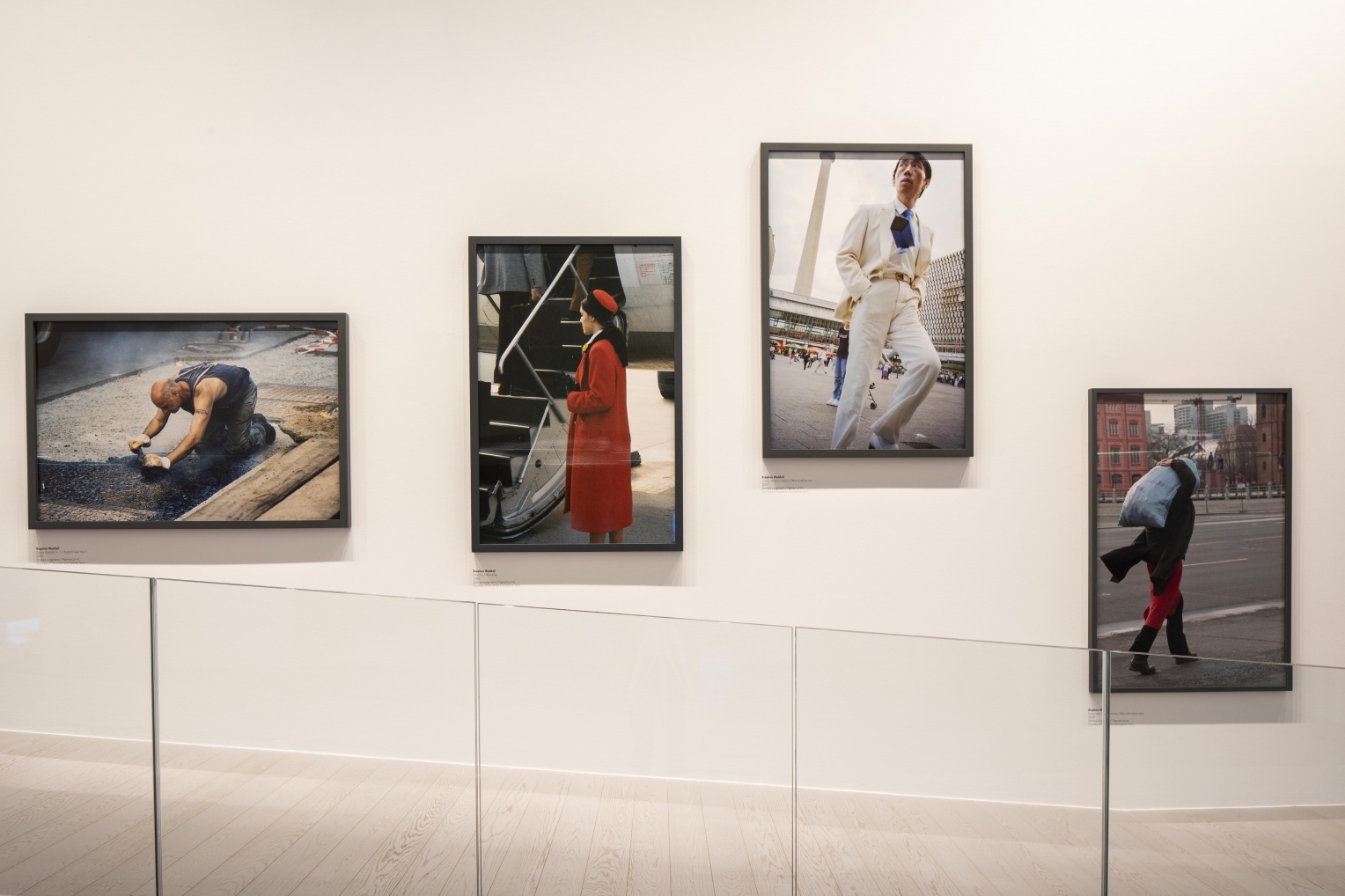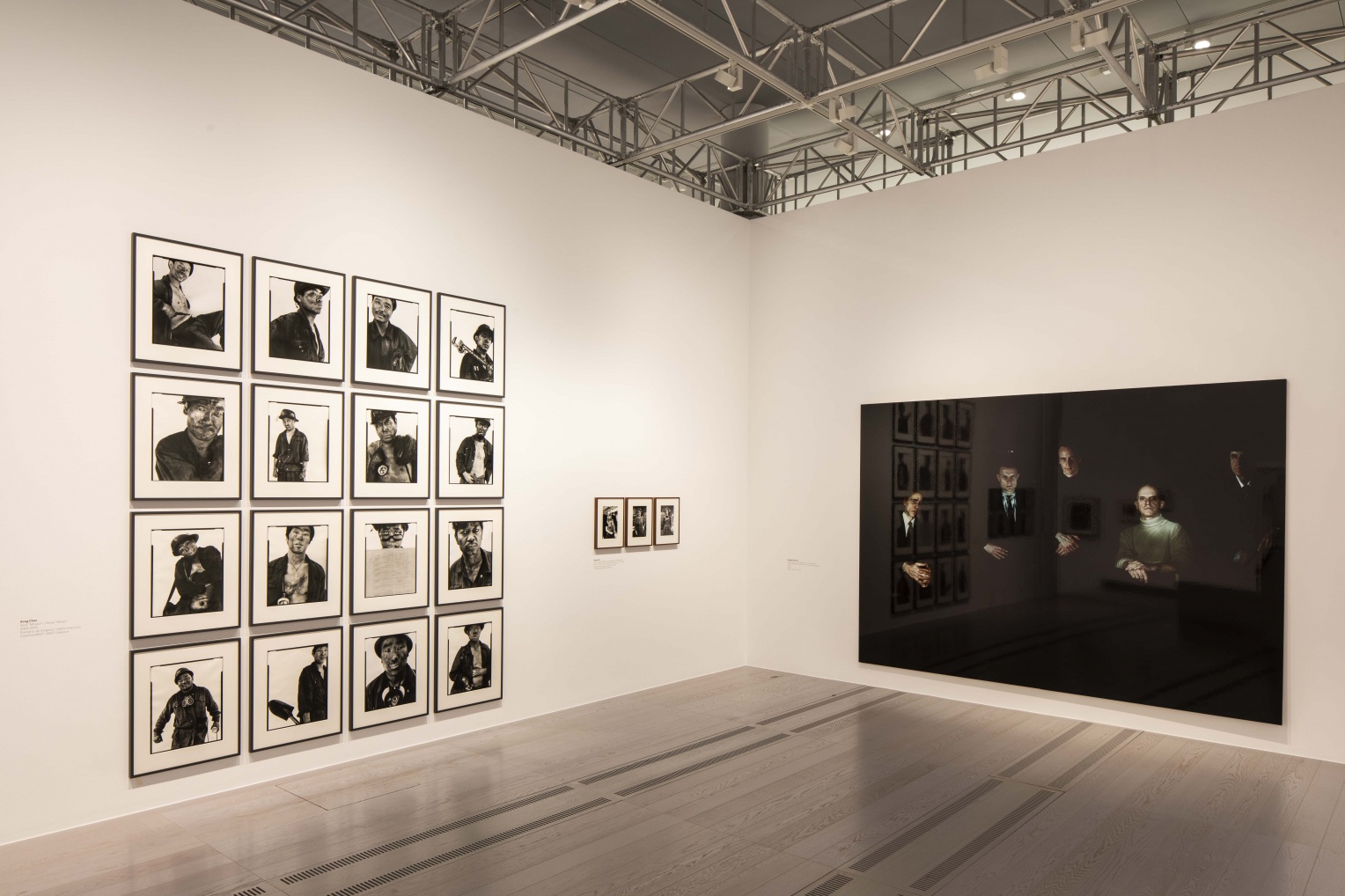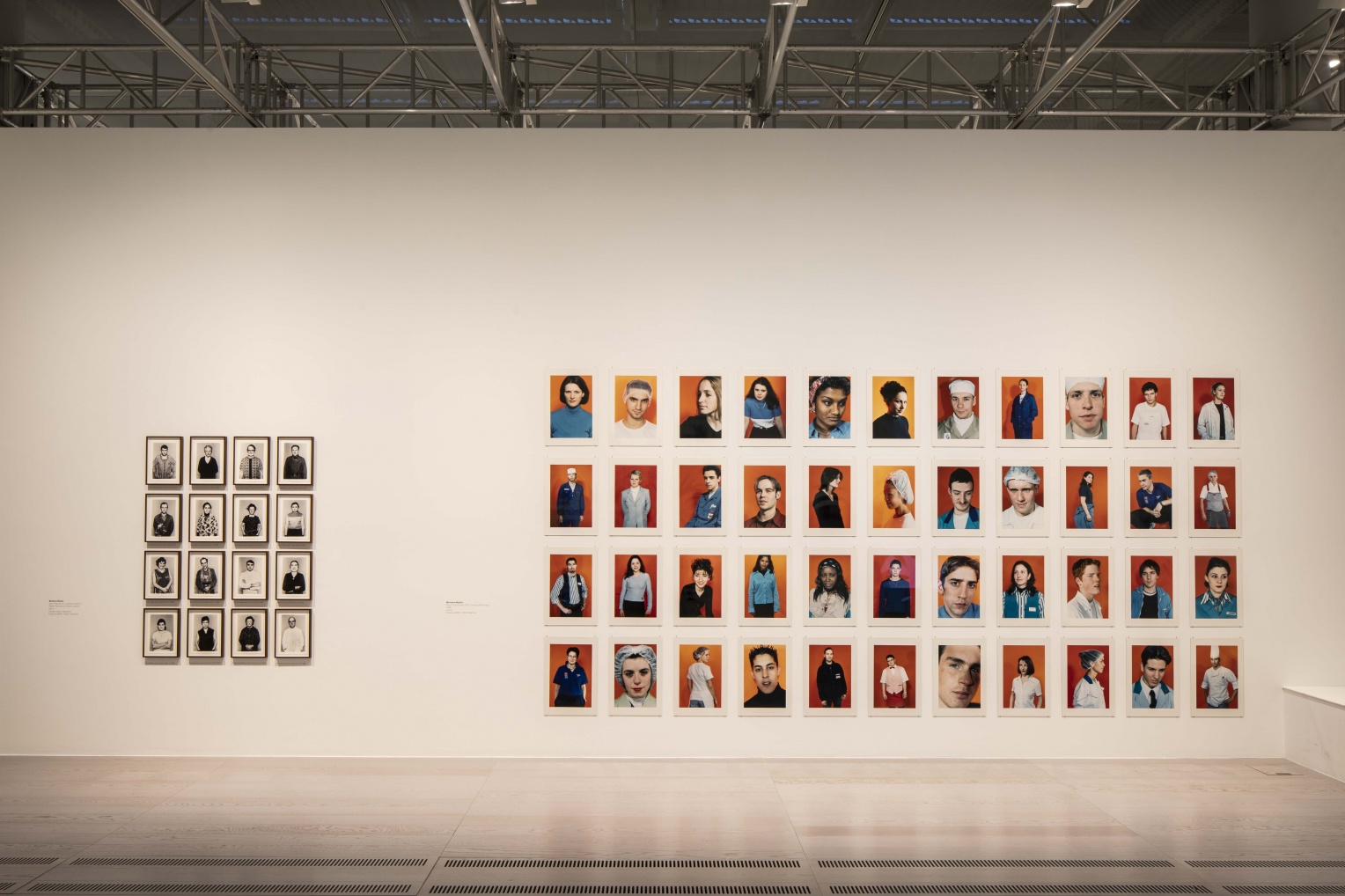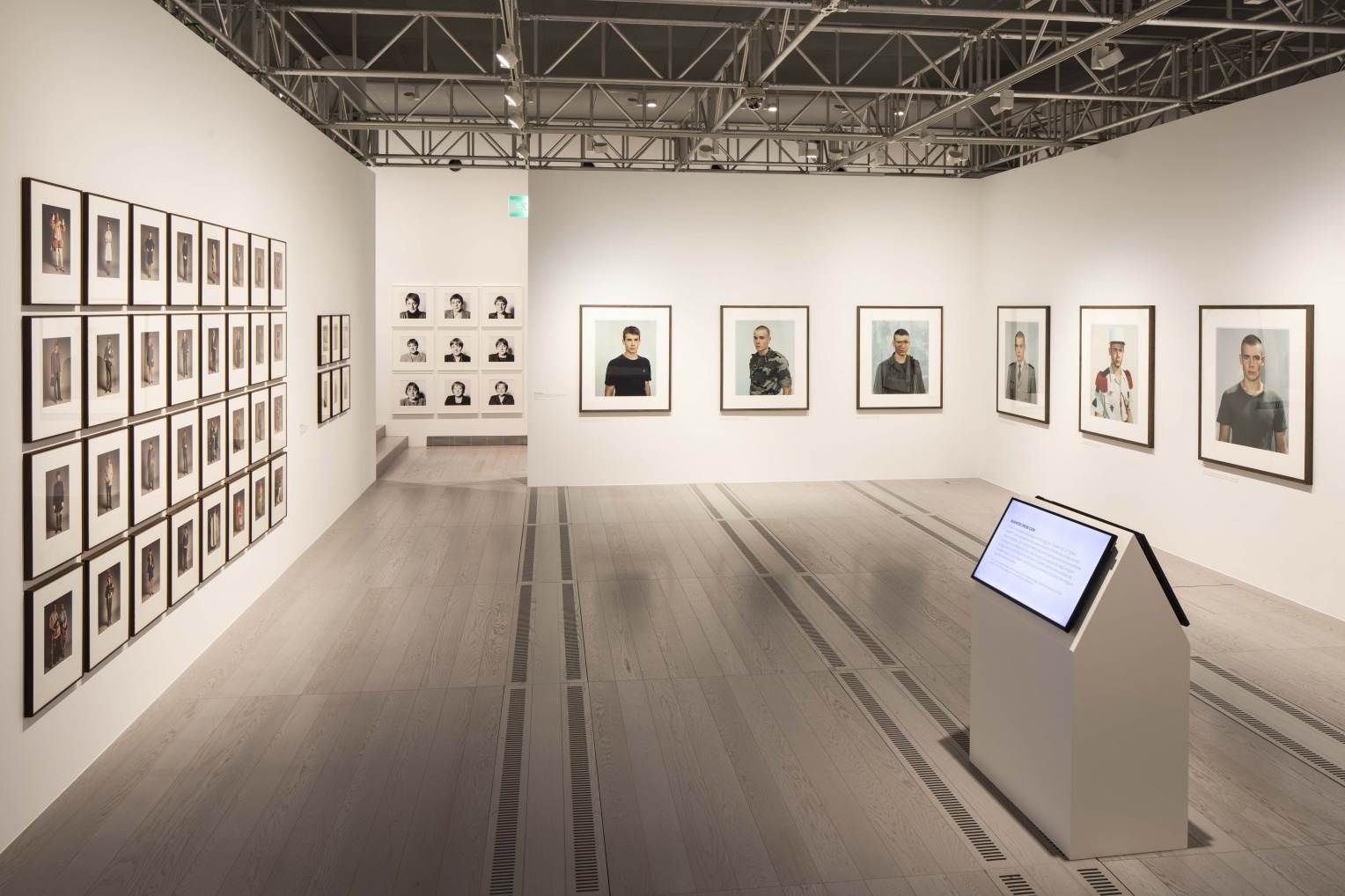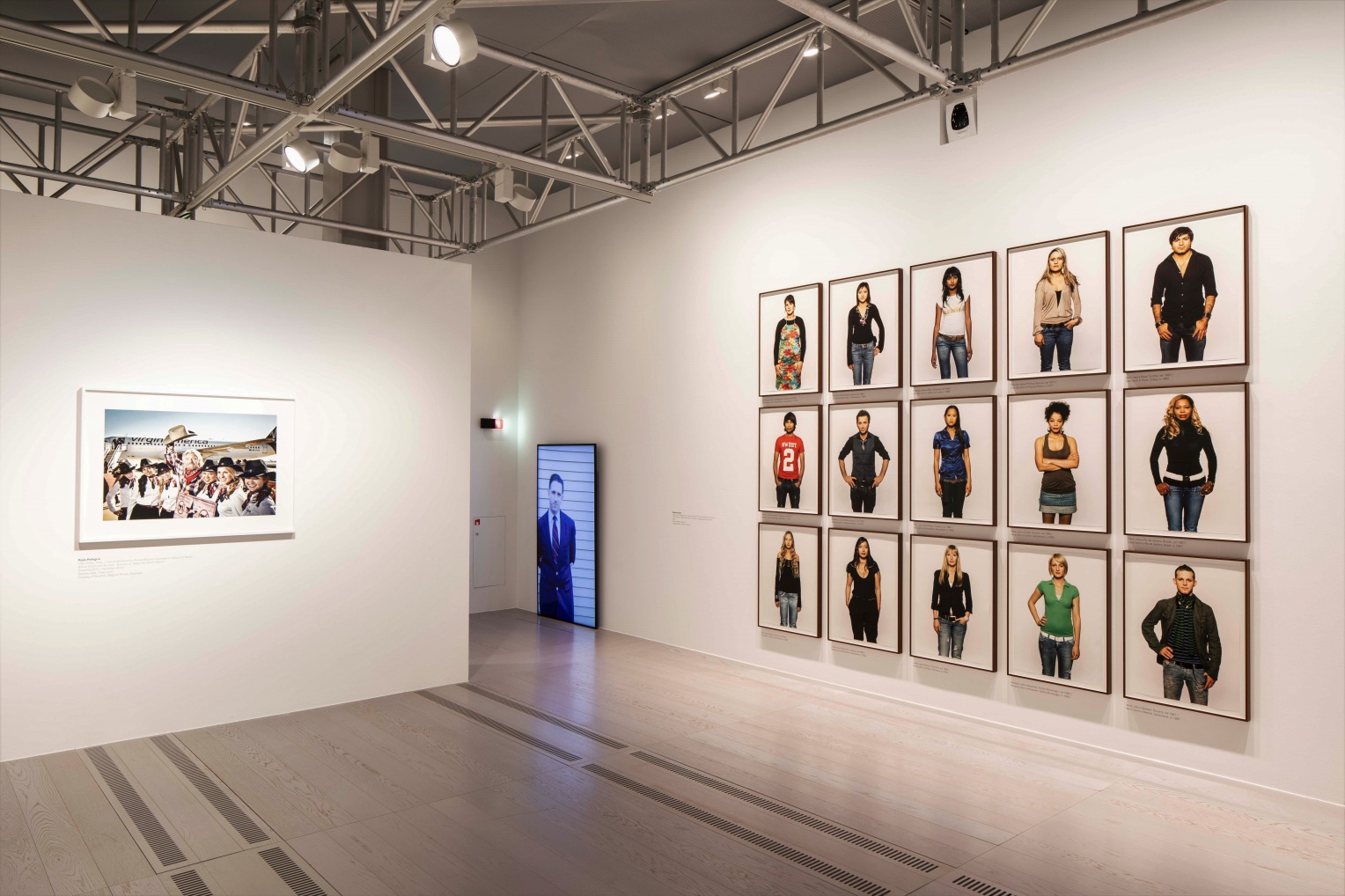The photographs of Stephen Waddell draw us into the subject right at the start of the exhibition: to the left we see an “asphalter”, a road worker who has been photographed in a sleeveless t-shirt and sturdy work trousers, kneeling and bending down to spread the hot tar. The ground steams, the worker is trying to deal with the heat at the same time as spreading the asphalt as evenly as possible. In the picture next to it, we see - much cleaner - a flight attendant, a stewardess in a bright red uniform. She isn’t wearing a simple work dress, but an impressive, aesthetically styled uniform right at the foot of the aeroplane’s steps. The man in the white suit is reminiscent of Tom Wolfe, the famous journalist/writer and co-founder of New Journalism, whose bespoke white suits were his distinctive trademark. His suit with its wildly fluttering tie appears eccentric, frivolous, he seems to like his appearance best of all. The final picture, that of the bearer of a blue-silver shimmering plastic bag, plays against the red colours of the flight attendant. It shows us a service worker in the act of bringing a bulging bag to a customer or to his own home. His appearance combines everyday clothing with professional clothing, his fluttering coat reveals a red apron beneath.
Today, all over the world, we still differentiate between the “blue collar worker” and the “white collar worker”, two terms that are now commonly used in many languages across the industrialised world. In the 1990s a third term, “pink collar worker”, was introduced but was less widely used. Here, we differentiate between many types of job and forms of work through work clothes, between the usually blue utility suit or the overalls of the handworker and the factory worker on the one hand and on the other hand the white collar as a symbol for the suit, white shirt and tie, for the “administrative body”. The pink apron stands for many service providers in the health industry, the white apron for technicians, engineers, but also for butchers, bakers, printers, bookbinders, and many other vocations. Of course, over many decades and long into history the white apron has also served as a visual mark of gender and social roles. In many cultural contexts it is above all women who wear a white apron.
“Fashion, which reflects the psychology of everyday life, of habits, of aesthetic tastes,” writes Warwara Stepanowa, the constructivist artist and wife of Alexander Rodchenko, in an essay published in 1923, “resigns its place in an item of clothing that is designed for implementation in various areas of work, for a certain social action. This is clothing whose value is only shown in the work process, and which, outside real life, has no end in itself as a special form of ‘art work’.” Stepanowa is writing here of clothing in which the materials and its design, its functional purpose are central, while its appearance, its aesthetic aspects are of much lesser concern. For the “blue collar worker” in particular the usability and durability of clothing are important, as well as the degree of protection that its materials can provide against dirt and even against injury. Work clothes definitely assume a special position within the subject of “clothing”.
The exhibition initially presents photographs by a number of different photographers to demonstrate the variety of work clothes, their differences in time and in usage. A typical worker’s jacket in a magical picture by Graciela Iturbide, for example, cotton pickers bending low with their harvest sacks by Danny Lyon, a row of female nurses with their blue-and-white aprons in a stairwell by Alfred Eisenstaedt, “Small Trades”, as Irving Penn calls them - with two photographs of a fishmonger and two butchers -, a photograph by Walker Evans of two coal workers at the port of Havana, the work outfits of farmers in colour photographs by Albrecht Tübke, the women and their work clothing in the assembly halls of Fiat in Turin (in photographs by Paola Agosti), as well as group photographs that demonstrate the unifying, generalising, protective aspects of work clothes for the group, the team.
The Mexican photographer Manuel Alvarez Bravo on the other hand offers us a first impressive image of almost archaic protective clothing, then the protective glove photographed at Toshiba by Hitoshi Tsukiji, the protective suits by Sonja Braas, and by Hans Danuser and Doug Menuez. Sonja Braas adds the important proviso: “An Abundance of Caution”, the title of the series from which the photograph is taken, “deals with this colonization of our lives by fear and the resulting sense of impending doom, the low-intensity fear that surrounds us, shapes our space of action and forms a backdrop of our experiences and interpretations.” And for Hans Danuser we must add that the works shown here come from the large project “In Vivo”, in which Hans Danuser “presents” in seven chapters work places in taboo zones of society, of the world of knowledge production.
In the first large room, the work clothes of a small factory in Switzerland (half of the employees are Italians and Spaniards) in the photographs of Barbara Davatz collide with the uniforms of the apprentices in the largest grocery company in Switzerland, “Migros” (photographed by Marianne Mueller), and the white collar workers in offices photographed by Florian van Roekel in “Office” meet the dark black overalls of miners in the photographs by Song Chao from China and then the three apronned women photographed by Helga Paris, who took the pictures in a clothing factory. In all these works we clearly sense how vividly not only work clothes but also posture at work contribute to the story of working conditions.
In the background of the room are two large works by Clegg & Guttmann, the “Last Effort” of two young people during an evening concert in front of an audience and “A Group Portrait of the Executives of a Worldwide Company”, both taken in the 1980s. The almost sombre background and the formal arrangement of the two Clegg & Guttmann pictures show clearly that the difference between “blue collar” and “white collar” in no way simply denotes the activity, simply follows the functionality of the work in question. The work clothing also expresses differences in social status and social class. The photographs of work clothes should be read and understood with an eye for textiles as well as for the sociological implications. Let’s take a closer look at that here now:
Clegg & Guttmann have long practised a form of portrait photography in which they do not follow the rules of the historian, who tries to narrate an event honestly and seriously (photographically document). Instead, they flirt with the role of the court painter or the fictional narrator, who emphasises the event differently depending on their intentions, or even hides aspects or seeks to trick the audience. The motivation for this work was their interest in the type of portrait that still adorn the “Annual Report of the Management ”. Portraits that, at first glance, are reminiscent of the educated, confident, power-conscious middle class of Dutch portraiture in the 17th century; portraits in which presence gives way to representation, natural appearance to a rhetorical demeanour specific to a certain role: it is not the person that counts, but rather the position, the power, the role that they occupy.
In our example, the five-figure group of “Executives of a Worldwide Company” (1980): five men in a row, like pearls on a thread that trails loosely across the paper. The light falls only on their faces, their hands and the triangular flash of collar, white shirt and tie. The rest of the figure and its surroundings disappear in the sort of darkness found in Old Masters. One of them is clearly recognisable as the boss – not the image in the topmost position, nor the best-dressed figure, but rather the figure whose balance of assertiveness (in his gaze) and confident composure (the folded hands) shows him to be the best player of his role.
Thus, we move progressively from work clothes to uniforms. The Italian language has two words for this: “uniformi” and “divida”. One word strongly emphasises the unifying aspect, the other highlights the dividing aspect, the aspect of separation. They show inclusion and exclusion to be two related, connected actions. Military and civilian uniforms have always influenced each other. Both can convey pride and respect, yet both can also be a burden. In their book “Civilian Uniforms as Symbolic Communication” (2017), the two authors Hackspiel and Haas differentiate between the two forms of uniform: “Comprehending civilian uniforms as a medium of symbolic communication means not defining them principally via their protective function - as is the case for military uniforms - or their aesthetic implications. Instead, they are defined via their function, which is to gesture symbolically to the organisation of the instance that initiated their design and wear, as well as to the society and culture in which they are embedded. (...) They signal membership of a community, whether that is a state institution, a social or a religious group, a club or association or a private company. However, uniforms can also exclude, mark lines of division and make social conflicts visible, even intensify them. If you understand how to read them, they give you information about the rank, status, tasks, competencies, and responsibilities of the person wearing the uniform.”
In the second large room, we encounter the seven impressive photographs of “Olivier”, the young Frenchman Olivier Silva, whom Rineke Dijkstra portrayed shortly after he was accepted as a legionnaire and subsequently another six times during his 36-month training programme. The series makes almost painfully visible how his time in the military and the wearing of the uniform changes him, appears to harden him. “The idea was to follow a soldier, someone who comes in soft and young, then turns tough,” said the artist.
Directly opposite this hang the photographs of a large series by Timm Rautert, showing Germans in civilian uniforms. The series gives the impression of a rich and varied proof of the statement of Hackspiel and Haas that fashion is defined by the conscious design of variance and variety, while uniforms aim for consistency and precision. To the left and right of these we see the impressive forms of uniforms in works by Sergey Bratkov, Roland Fischer’s monk and nun and in works by Judith Joy Ross: military, civilian and clerical work and symbolic clothing. In the adjoining corridor, the nine photographs by Herlinde Koelbl show the political uniform of a young Angela Merkel. Around the corner we find another two uniform works by Timm Rautert: from his series “Guardia di Finanza” and “The Hutterites”.
“Kleider machen Leute,” - the clothes make the person - so goes a German saying. But in Italian, significantly, it’s the other way around: “L’abito non fa il monavo” (the dress does not make the priest). The saying “vesti un bastone e ti parrà un signore” (dress a stick and you will look like a gentleman), however, tends more towards the German meaning. One saying refers to the power of the surface, of appearance, the other to the power of depth, of essence, of being. “Kleider machen Leute” is a famous saying, but it is also the title of a a novella by the well-known Swiss writer Gottfried Keller. In this story, the tailor’s apprentice Wenzel Strapinski manages to climb the social ladder thanks to his fancy clothing.
In the final room (and on the way there) the works of Oliver Sieber, Barbara Davatz, Andreas Gelpke, Andri Pol, Paolo Pellegrin, Herb Ritts and Weronika Gesicka thematise the progressive development of work clothes, of uniforms to style and fashion. In Sieber’s works, the appearance moves towards a personal and group uniform, in Gelpke’s the suit and dress as middle-class uniforms are contrasted with nakedness and with the body as an anti-middle class work clothing, Paolo Pellegrin’s photograph of Virgin Sun Airlines and the company’s founder and owner Richard Branson the uniform becomes part of the company branding, while for Weronika Gesicka uniform conduct and existence is exaggerated into caricature. The two photographs by Brad Herndon and Hiroji Kubota thematise the contrast between camouflage and proud uniform, between wanting to be clearly and symbolically impressive and visible and wanting to be extremely invisible. In fashion history, women first wore men’s work clothes as camouflage, to hide that they were really women, sometimes even to be able to fight in wars as soldiers, like the men. But later they began to wear men’s work clothes as a form of liberation from the usual strict norms governing dress and acceptable social roles. Work clothing, cross-dressing has repeatedly appeared in female fashion of the last two decades as an image of a new, cool self-image for women. The exhibition includes catwalk images from Dior, Balmain, Balenciaga, Byblos, Etsy, Moschino, Vêtements, Calvin Klein, Liam Hodges, Hi Vis, Chalayan, Burberry, D&G, Cristina Neves, Louis Vuitton, showing how work clothes change in fashion. (MOVED TO THE END)
The title "Beauty lies inside", given to the final portraits by Barbara Davatz, refers to an ambiguous slogan that was printed on the carrier bags of H&M for a time. She invited sales staff employed by the fashion house into her studio in order to photograph them outside their work contexts. Barbara Davatz wasn’t aiming for a character study, but rather “for a kind of sociological and ethnographical status report: what do young Swiss people look like in the 21st century? What does identity mean in a globalised world? (Peter Pfrunder) All the employees live and work in Switzerland, but come from a large variety of countries, from Kosovo, Serbia, Rio de Janeiro, India and more, including Switzerland, of course. What unites them here is on the one hand their access to affordable H&M clothing, and on the other hand the global idea of work clothing that is emphatically marketed as anti-uniform, as the global identity of a young generation.
The work of Tobias Kaspar has the final word in the exhibition. For his series “The Japan Collection” he photographed pieces of embroidery in the archive of a Swiss textile manufacturer. These designs have been been manufactured exclusively for the Japanese market since the 1960s, when Japan opened up as a market for western consumer goods. Kaspar scales the small embroidered works up to almost life-size figures, so that every stitch, every thread and every error is made visible. Simultaneously, he says, there appears a broken mirror image of contrasting projections – here figuratively as well, between the waiter and the lady, between his service uniform and the dress denoting her status. - And the entire exhibition is guarded by sentries in uniform, in the life-size videos made by Marianne Mueller. Accompanied by 6 additional media stations

